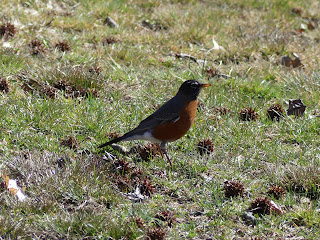American Robin Among Goblin Balls (aka Sweetgum Seed Balls)
Last March I spotted this American Robin foraging among goblin balls. I have to confess that prior to writing this I've never referred to American Sweetgum seed balls as "goblin balls", though the sharp spikes on sweetgum seed balls do seem like the sort of things that mischievous goblins might put out to annoy/vex us. And this article on sweetgums suggests this is a valid term for them (but rest assured that arborists are convinced that goblins are not involved in the production or distribution of these things).
Though sweetgum isn't the favorite wood of woodworkers, these seed balls are probably the main reason this tree isn't terribly popular in yards. For those who like to walk barefoot, these seed balls constitute a minefield of pain [1].
Although our robins are unlikely to eat the seeds in these seed balls [2], some of our birds will eat them. These mostly seem to be stouter-billed birds like sparrows, cardinals, and finches, with American Goldfinch being major afficionados of these seeds. Furthermore, while their flowers aren't particularly showy, they are considered a good nectar source, and the tree itself is a host plant for numerous butterflies/moths. All in all, these trees are ecologically important.
 |
| March 16, 2023 at the Raritan Water Power Canal Photo 267709505, (c) jpviolette, some rights reserved (CC BY-NC) |
Here's a closeup of the seed balls when they're young and still on the tree. (They're softer at this stage.)
 |
| November 17, 2021 at Duke Farms Photo 170812924, (c) jpviolette, some rights reserved (CC BY-NC) |
[1] I suspect they're not a lot of fun to rake either.
[2] It wouldn't surprise me if the seed balls attract insects that robins would find tasty though.



Comments
Post a Comment